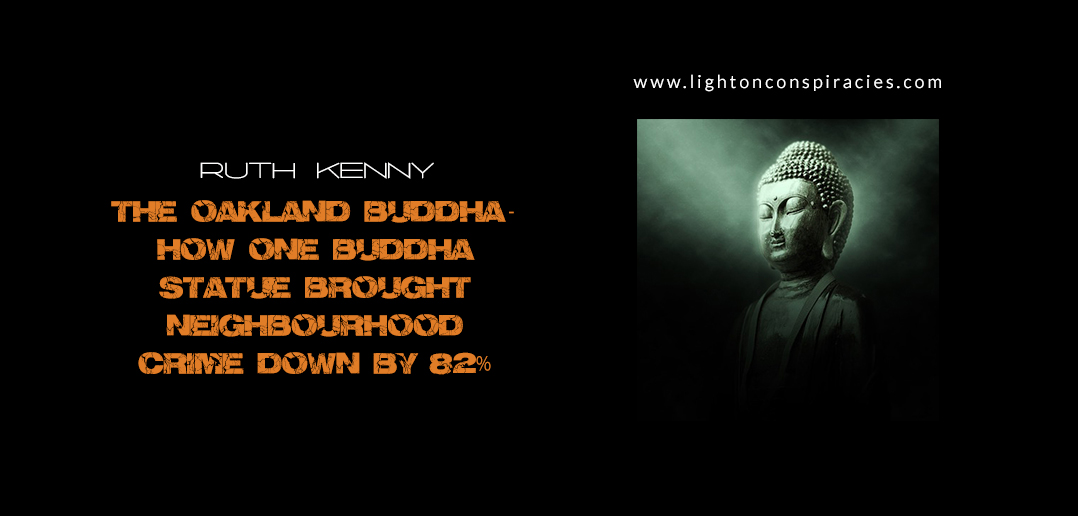The Oakland Buddha – How One Buddha Statue Brought Neighbourhood Crime Down by 82%
By Ruth Kenny on August 24th, 2018 Category: Travel
The neighborhood of 11th Avenue and East 19th Street was formerly a rough part of Oakland, riddled with a variety of illegal activities ranging from littering and vandalization to drug dealing, robberies, prostitution, and assaults. That is until one local, Dan Stevenson, purchased a 60-cm-tall stone statue of Buddha and placed it on the street corner opposite his home. People were constantly dumping mattresses, couches and other junk there, and all kind of shady characters would hang around, so he figured the statue would be an improvement. But, in this case, calling the effect of the statue an improvement would be a gross understatement.
BOOK AD
Coup d’etat in Slowmotion
by Ole Dammegard
For almost 30 years investigator Ole Dammegård has been on a quest to find the truth behind some of the worst conspiracies in the history of world – such as the murders US President John F. Kennedy, Robert Kennedy, John Lennon and the blowing up of m/s Estonia killing at least 852 innocent people. This has taken him on a very frightening and dangerous journey into unknown territories. What has been claimed as acts by lone madmen has turned out to be connected to the International military industrial complex and top level high finance, all sanctioned locally behind dark smoke screens. This ground breaking book focuses on the assassination of the Swedish Prime Minister Olof Palme, who was gunned down in February 1986. In Volume I secret agents, mercenaries, professional assassins, top politicians and innocent scapegoats fill the pages of this explosive book which shows a side of Sweden and the western world earlier glimpsed by very few. This is not the private opinion of one individual, but the disclosure of a puzzle so vast that it blows your mind. Let the detailed content speak for itself, but do not accept it uncritically. Read it – make up your own mind – then spread it.
To preview the book click on the thumbnail below: [columns] [column size=”1/2″]Vol 1 Paperback[/column] [column size=”1/2″]Vol 2 Paperback[/column][/columns]
Buy The eBook here
“I would have stuck Christ up there if he would have kept the mattresses off,” Stevenson jokingly told Oakland North. “Except Christ is so controversial with people. Buddha is a neutral dude. ”
Initially, he had merely hoped that the presence of the figure would bring a sense of serenity to the troubled neighborhood, or, at the very least, make people think twice before littering . What Stevenson certainly didn’t expect was the Buddha statue to create a ripple effect that would result in the utter transformation of his neighborhood.
https://www.facebook.com/photo.php?fbid=10207787728906020&set=a.1672569048918&type=3
First, the littering stopped, much to the delight of most residents, but then something even more remarkable happened – locals started cleaning up the trash that was already there. Drug dealers and prostitutes started migrating away from the area as well, and vandals stopped painting graffiti on walls. Soon, local Vietnamese immigrants in the neighborhood began flocking to the statue, bringing offerings of fruit, garlands, and sticks of incense. Eventually, a neighbor named Vina Vo and her son Cuc Vo approached Stevenson with the request that they could care for the statue, to which he agreed.
First, they built a small platform for the Buddha to sit on and began to maintain the area around him.
“In our religion, Buddha is not supposed to be on the ground,” Cuc Vo told Oakland North.
In time they painted him as well, first just white, but then flesh-colored with a golden robe. The little shrine even has a name plaque that reads “Phap Duyen Tu,” meaning “tranquility.” Every time they want to make a change to the shrine the Vo family approach Stevenson for permission, but he keeps telling them “It’s your Buddha, I’m out of this now.” Nonetheless, he’s always happy to receive a plate of fruit or a Vietnamese delicacy every time he lets them know that they can do whatever they want.
In the time since Stevenson erected the statue, the overall crime rate in the neighborhood had dropped by an incredible 82%. Police statistics showed that between 2012 and 2014 “robbery reports went from 14 to three, aggravated assaults from five to zero, burglaries from eight to four, narcotics from three to zero, and prostitution from three to zero.”
“It’s become this icon for the whole neighborhood,” Dan Stevenson said. “There’s a lot of people that are not Buddhist that really come and just talk in front of him, they walk their dogs, they stand there—it’s a place where people meet and talk. It’s just cool.”
“He’s a popular little guy,” Stevenson continued. “He’s got a Facebook page. He’s got a Twitter account. He’s more connected socially than I am. He’s a great little guy, I guess. But it’s amazing, an amazing thing.”














